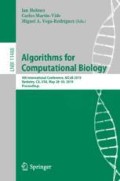Abstract
An important problem in genome comparison is the genome sorting problem, that is, the problem of finding a sequence of basic operations that transforms one genome into another whose length (possibly weighted) equals the distance between them. These sequences are called optimal sorting scenarios. However, there is usually a large number of such scenarios, and a naïve algorithm is very likely to be biased towards a specific type of scenario, impairing its usefulness in real-world applications. One way to go beyond the traditional sorting algorithms is to explore all possible solutions, looking at all the optimal sorting scenarios instead of just an arbitrary one. Another related approach is to analyze all the intermediate genomes, that is, all the genomes that can occur in an optimal sorting scenario. In this paper, we show how to count the number of optimal sorting scenarios and the number of intermediate genomes between any two given genomes, under the rank distance.
JPPZ is supported by FAPESP grant 2017/02748-3. LC is supported by an NSERC Discovery Grant and a Sloan Foundation Fellowship. JM is supported by FAPESP grant 2018/00031-7.
Access this chapter
Tax calculation will be finalised at checkout
Purchases are for personal use only
References
Bergeron, A., Mixtacki, J., Stoye, J.: A unifying view of genome rearrangements. In: Bücher, P., Moret, B.M.E. (eds.) WABI 2006. LNCS, vol. 4175, pp. 163–173. Springer, Heidelberg (2006). https://doi.org/10.1007/11851561_16
Bourque, G., Pevzner, P.A.: Genome-scale evolution: reconstructing gene orders in the ancestral species. Genome Res. 12(1), 26–36 (2002)
Braga, M.D.V., Willing, E., Stoye, J.: Genomic distance with DCJ and indels. In: Moulton, V., Singh, M. (eds.) WABI 2010. LNCS, vol. 6293, pp. 90–101. Springer, Heidelberg (2010). https://doi.org/10.1007/978-3-642-15294-8_8
Braga, M.D., Stoye, J.: The solution space of sorting by DCJ. J. Comput. Biol. 17(9), 1145–1165 (2010)
Compeau, P.E.C.: DCJ-Indel sorting revisited. Algorithms Mol. Biol. 8(1), 6 (2013)
Cosner, M.E., Raubeson, L.A., Jansen, R.K.: Chloroplast DNA rearrangements in Campanulaceae: phylogenetic utility of highly rearranged genomes. BMC Evol. Biol. 4(1), 1–17 (2004)
Feijão, P.: Reconstruction of ancestral gene orders using intermediate genomes. BMC Bioinform. 16(14), S3 (2015)
Feijão, P., Mane, A., Chauve, C.: A tractable variant of the single cut or join distance with duplicated genes. In: Meidanis, J., Nakhleh, L. (eds.) RECOMB-CG 2017. LNCS, vol. 10562, pp. 14–30. Springer, Cham (2017). https://doi.org/10.1007/978-3-319-67979-2_2
Feijao, P., Meidanis, J.: SCJ: a breakpoint-like distance that simplifies several rearrangement problems. IEEE/ACM Trans. Comput. Biol. Bioinform. (TCBB) 8(5), 1318–1329 (2011)
Feijão, P., Meidanis, J.: Extending the algebraic formalism for genome rearrangements to include linear chromosomes. IEEE/ACM Trans. Comput. Biol. Bioinform. 10(4), 819–831 (2013)
Hannenhalli, S., Pevzner, P.A.: Transforming men into mice (polynomial algorithm for genomic distance problem). In: 1995 Proceedings of the 36th Annual Symposium on Foundations of Computer Science, pp. 581–592. IEEE (1995)
Jamshidpey, A., Jamshidpey, A., Sankoff, D.: Sets of medians in the non-geodesic pseudometric space of unsigned genomes with breakpoints. BMC Genomics 15(6), S3 (2014)
Kim, J., et al.: Reconstruction and evolutionary history of eutherian chromosomes. Proc. Nat. Acad. Sci. 114(27), E5379–E5388 (2017)
Larget, B., Kadane, J.B., Simon, D.L.: A Bayesian approach to the estimation of ancestral genome arrangements. Mol. Phylogenet. Evol. 36(2), 214–223 (2005)
Lubell, D.: A short proof of Sperner’s lemma. J. Comb. Theory 1(2), 299 (1966)
Miklós, I., Kiss, S.Z., Tannier, E.: Counting and sampling SCJ small parsimony solutions. Theor. Comput. Sci. 552, 83–98 (2014)
Ouangraoua, A., Bergeron, A.: Combinatorial structure of genome rearrangements scenarios. J. Comput. Biol. 17(9), 1129–1144 (2010)
Palmer, J.D., Herbon, L.A.: Plant mitochondrial DNA evolved rapidly in structure, but slowly in sequence. J. Mol. Evol. 28(1), 87–97 (1988)
Pevzner, P., Tesler, G.: Genome rearrangements in mammalian evolution: lessons from human and mouse genomes. Genome Res. 13(1), 37–45 (2003)
Shao, M., Lin, Y., Moret, B.: Sorting genomes with rearrangements and segmental duplications through trajectory graphs. BMC Bioinform. 14(15), S9 (2013)
Sperner, E.: Ein satz über untermengen einer endlichen menge. Math. Z. 27(1), 544–548 (1928)
Tannier, E., Zheng, C., Sankoff, D.: Multichromosomal median and halving problems under different genomic distances. BMC Bioinform. 10(1), 120 (2009)
Yancopoulos, S., Attie, O., Friedberg, R.: Efficient sorting of genomic permutations by translocation, inversion and block interchange. Bioinformatics 21(16), 3340–3346 (2005)
Zanetti, J.P.P., Biller, P., Meidanis, J.: Median approximations for genomes modeled as matrices. Bull. Math. Biol. 78(4), 786–814 (2016)
Author information
Authors and Affiliations
Corresponding author
Editor information
Editors and Affiliations
Rights and permissions
Copyright information
© 2019 Springer Nature Switzerland AG
About this paper
Cite this paper
Zanetti, J.P.P., Chindelevitch, L., Meidanis, J. (2019). Counting Sorting Scenarios and Intermediate Genomes for the Rank Distance. In: Holmes, I., Martín-Vide, C., Vega-Rodríguez, M. (eds) Algorithms for Computational Biology. AlCoB 2019. Lecture Notes in Computer Science(), vol 11488. Springer, Cham. https://doi.org/10.1007/978-3-030-18174-1_10
Download citation
DOI: https://doi.org/10.1007/978-3-030-18174-1_10
Published:
Publisher Name: Springer, Cham
Print ISBN: 978-3-030-18173-4
Online ISBN: 978-3-030-18174-1
eBook Packages: Computer ScienceComputer Science (R0)

